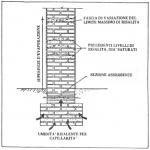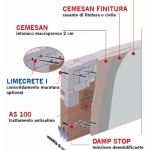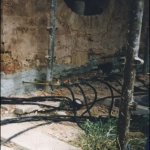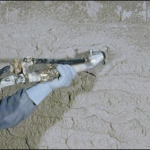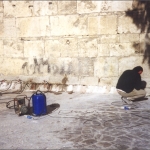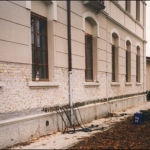ISO System
Systems against rising damp in masonry and cultural heritage
The DAMP STOP technology by injection can be defined as a final solution for the problem of rising damp.
The injection system is extremely versatile and can be used in any kind of masonry (as differentiated by type, consistency, capillary pressure and salinity level), in all categories of buildings (historical, urban, suburban or rural etc.) and in various types of structure/construction (above – ground, underground, in waterbeds, etc.)
The main advantages include very good penetration capacity of product , permeability to water vapour, high chemical resistance to alkali and micro – organisms and durability. The system is very effectiveness and suitable for Cultural Heritage protection.
DAMP STOP technology is a brand guaranteed by G&P intech all over the world.
Highly specialised personnel is available for assistance in application.
CEMESAN is a special macroporous plaster of 2 cm thickness able to solve rising damp problems for masonry. The product is available in different range of use that is ready mix CEMESAN PREMIX and a cost saving solution special for export CEMESAN compound to be add to local sand. The resulting high degree of humidity diffusion makes this an ideal component in mixes used to cover masonry subject to rising capillary and interstitial humidity. The type CEMESAN R is hydraulic lime basis for hystorical buildings and monuments.
PRODUCTS
DAMP STOP is a technology that includes a special injection material DAMP STOP available in three different formulations:
- DAMP STOP I: for application in masonry with low saline content. This type is usable in most cases.
- DAMP STOP SI: for application in masonry where the saline contents (especially chloride) is very high e.g. near the sea or when buildings are used for particular purposes.
- DAMP STOP W: very low VOC, without solvent, concentrated product water base for application in poorly – ventilated environments. Suitable for export.
TECHNICAL DATA Type I – SI W
- Sp. Gr. 0.85 g/cm3 0,98 g/ cm3
- Viscosity at 20°C 25-35 cps 30 – 35 cps
- Reduction of permeability to vapour (DIN 52615) ≤ 5% ≤5%
- Frost (freeze/thaw) test on treated brick (DIN 53122) ≥20 Cycles ≥20% cycles
INSTALLATION
Before injecting the product, the construction or masonry to be treated has to be examined andn analysed chemically to determine the degree of humidity present, the saline content, masonry type and to establish whether any plaster is present.
DAMP STOP is applied in the phases described below:
Preparation of the support with removal of any plaster over a section of at least 50 cm. from the floor level. It is generally best to remove plaster in an area extending to about 50 cm. above the evident line of humidity and saline laitance or efflorescence.
Preparation of the products: DAMP STOP I-SI is ready to use. DAMP STOP W has to be diluted in clean water at the rate of 1:10. The product diluted has to be used in the same day.
Preparation of the holes used for injection. The holes must be located at about 15 cm. above the indoor floor level and/or external ground level if the latter is at the same height as the internal flooring surface.
Any differences in level between internal and external floor/ground levels must be taken into consideration when determining the height of areas in which the product is to be applied.
Holes, which should have a basic diameter of 12 mm., are bored along one horizontal line if the face is in brickwork or along two horizontal lines if the face is formed by stone and/or other materials embedded with absorbent mortar. The centre distance of the holes can vary from 10 to 15 cm. depending on the degree of absorption of the materials found in the masonry face. Dept of the holes is normally equal to 75-80%of the total thickness and is reached in subsequent stages. The remaining 20-25% is reached by the liquid by diffusion.
When thickness exceed 90 cm., it is preferable to work on both sides of the masonry. For high masonry thicknesses (above 90 cm.), where injection will be carried out on one side only, the hole diametersn should be larger (14-16 mm.) to facilitate boring. It is usually preferable to make the holes with a downward inclination of 3-5%.
The DAMP STOP liquid is injected into the holes at variable pressure, depending on the absorption of the masonry, at an average of 5 bar. The equipment used is a special pump (DS 16) equipped with 16 nozzles fitted with build – in pressure gauges and injectors with rubber rings for control of liquid flow.
The injectors are introduced in the holes and then sealed.
Injection, which, on average, least 10-15 minutes, can be considered as terminated when the impregnating liquid visibly wets the surface of the masonry face. For subsequent plastering operations refer to G&P intech Technical Manual ( see also CEMESAN macroporous plaster).
Consumption of DAMP STOP liquid in masonry depends on various factors such as type and porosity level of the wall, capillary pressure, consistency, presence of fissures or void spaces. Normally consumption of DAMP STOP liquid is approx. 200 g/m/cm. of mbored thickness, while consumption of concentrated DAMP STOP W liquid is approx. 25 g/m/cm.
The DS 16 pump complete with 16 nozzles 30 cm length is manufactured by the Company and available upon request. Nozzles with different length are also availables.
CEMESAN PREMIX
Special macroporous plaster of 2 cm thickness able to solve rising damp problems for masonry. The resulting high degree of humidity diffusion makes this an ideal plaster for masonry subject to rising capillary and interstitial humidity. The version R is hydraulic lime basis material for hystorical buildings.
TECHNICAL DATA
aspect: gray powder
water mix 18-20%
yield for 2 cm thickness 24-25 kg/m2
Permeability to vapour µ (DIN 56215) 9-10
Thermal conductivity coefficient 0.25-0,30 W/mK
INSTALLATION
Remove the old plaster from the wall to be treated, clean thoroughly and then treat with the AS 100 W salinity stabilizer, if necessary.
Humidify the supporting surface thoroughly 15 to 20 minutes following application of the AS 100 W to determine the appropriate hygrometry grading.
Prepare the surface with a rough coating, preferably using the same CEMESAN PREMIX.
A few hours or one day after the application of the rough coating, the plaster can be applied.
Apply by machine or manual. The optimum thickness, which provides the correct degree of dehumidification is 2 cm. Finish off with a setting coat, using CEMESAN FINITURA or ready – mixed finishing plasters. Paint the surface by using those with good transpiration coefficient.
Ask to the Company for any assistance.
CEMESAN
Special compound to prepare on site a macroporous plaster able to solve rising damp problems for masonry. The product is available in a cost saving solution special for export CEMESAN compound to be add to local sand and water. The version R is hydraulic lime basis material for hystorical buildings.
TECHNICAL DATA
- aspect gray powder
- yield for 2 cm thickness 5-6 kg/m2
- Permeability to vapour µ (DIN 56215) 6-6.5
- Thermal conductivity coefficient 0.25-0.30 W/mK
INSTALLATION
Remove the old plaster from the wall to be treated, clean thoroughly and then treat with the AS 100 W salinity stabilizer, if necessary.
Humidify the supporting surface thoroughly 15 to 20 minutes following application of the AS 100 W to determine the appropriate hygrometry grading.
Prepare the surface with a rough coating, preferably using the CEMESAN binder itself with a binder/sand weight ratio of 1: 2.5/3.0. The rough coating must be applied loosely to a convenient thickness, using sand with granular grading of 2.5 – 3.0 mm.
A few hours or one day after application of the rough coating the plaster can be applied.
Mix 1 bag (20kg.) with 5-6 pails of builder’s sand (1 part of CEMESAN to 3 parts of sand) and 10-11 litres of water. Use sand with a maximum granular grading of 2 mm. The optimum thickness, which provides the correct degree of dehumidification is 2 cm. Finish off with a setting coat, using CEMESAN FINITURA or ready – mixed finishing plasters. Paint the surface by using those with good transpiration coefficient. Ask to the Company for any assistance.
AS 100 W
Special salinity stabilizer in liquid form, carried in water, suitable for the prevention and treatment of any form of salinity. AS 100 W , also used for very strong concentrations of salinity, is particularly suitable for application in masonry which has to be treated for rising damp by plaster. Through various combined and synergetic reactions, the chemical substances in this product inhibit the continual transformation (hydration-dehydration) of salts-especially hygroscopic salts-present in the masonry to which it is applied.
INSTALLATION
The surface to be covered must be free from its old plaster and throughly cleaned. Apply the product to the masonry, using a low-pressure sprayer or brush and working from the lower parts upwards until the surface is saturated. Normally, two coats of the product are sufficient and the second coat should be applied over the first while still wet.
Application of a rough coating of CEMESAN plaster or other type of compatible plaster must be carried out following treatment with AS 100 W , but the surface has to be previously humidified with water. Note that if application of rough coating takes place after a number of hours, there may be problem with adhesion of the plaster.
The yield is approx. 0.3-0.5 kg/m2.


